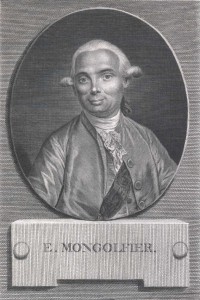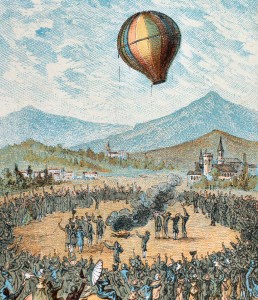
Published on June 4, 2012
On June 4, 1783, the two Montgolfier brothers, Joseph-Michel Montgolfier and Jacques-Étienne Montgolfier, demonstrated their unmanned hot air balloon at Annonay, Ardèche, France. Called a globe aérostatique by the brothers, the Montgolfier balloon was and remains to this day an astonishing invention — with it, the two brothers were the first to successfully achieve manned flight.
As witnessed by numerous dignitaries, their unmanned balloon was filled with heated air and flew a total distance of 2 km (1.2 miles), in a flight that lasted fully 10 minutes. During the flight, it achieved an estimated altitude of 1,600-2,000 m (5,200-6,600 ft) — over a mile aloft.

Jacques-Étienne Montgolfier, five years younger than Joseph-Michel, then proceeded to Paris to make further demonstrations of the balloon. While there, he set about the task of creating a larger balloon that would be capable of carrying a man aloft. He joined with the wallpaper manufacturer Jean-Baptiste Réveillon to constructed a 1,060 m3 (37,500-cubic-foot) balloon made of taffeta that was coated with a varnish of alum to ensure adequate fireproofing. Réveillon’s touch at wallpaper design was translated to the large taffeta of the balloon, which he adorned with blue and gold, covering the sides with flourishes, suns and the signs of the zodiac. A more grand aerial contraption could not have been conceived by any other than Réveillon.
Testing the Perils of the Atmosphere
The flight, however, would have grave risks. Quite literally, nobody understood the effects of high altitudes on living things. Many felt that if a man were to be as high as 5,000 feet, he would find that there was no air — the theory being that the air clung closely to the earth and mountainsides. Others worried about the effects of the sun.
To solve the dilemma, the King of France, Louis XVI, recommended that they fly the balloon first with a duck, a rooster and a sheep aboard. In honor of the event, the sheep was honorably christened Montauciel, which translates to “Climb-to-the-Sky.” Neither the rooster nor lowly duck, it seemed, were worthy in comparison and thus remained unnamed.
The animals were not selected at random, but rather with careful attention to scientific inquiry. The sheep was to represent something close to the physical qualities of a human, while the two birds were on board to serve as scientific controls or constant — the duck, it was felt, would undoubtedly survive as it was accustomed to high altitude flight, while the rooster, still a type of bird, was only accustomed to low altitude living. Based on their condition at landing, assuming a safe return to earth, the varying conditions of the three animals would be weighed before another flight would take place.
The Sheep, Duck and Rooster Survive
Thus, on September 19, 1783, a little more than three months after their first flight, the Montgolfier balloon would ascend with the three animals aboard in a basic that had been built around the bottom of the balloon’s central hot air channel. The flight would take place from the gardens of the Palace of Versailles, near Paris. Unconcerned with the risk of failure, Montgolfier invited King Louis XVI of France and Queen Marie Antoinette to observe.
As it happened, everything went perfectly. The flight traveled 3 km (2 miles) and lasted for approximately eight minutes. The balloon and its animal cargo achieved the lofty altitude of approximately 460 meters (1,500 feet) before returning to earth to land safely. All three animals survived.
A New Balloon is Built
This success lead Étienne back to his wallpaper manufacturer friend Réveillon to construction a much larger balloon so as to be able to lift human beings into the air. At once, they started construction of a 1,700 m3 (60,000-cubic-foot) balloon. It was a monumental work, measuing seventy-five feet tall and spanning fifty feet in diameter. Once again, Réveillon’s wallpaper artistry played a big role and the balloon was adorn with extensive gold and painted art, this time composed of gold designs such as the fleur-de-lis, signs of the zodiac, and more suns were set against a a deep blue background. To honor their chief benefactor, the King of France, Louis XVI’s face was painted in the center, surrounded by his royal monogram. Finally, red and blue drapery with golden eagles were hng around the base of the balloon.
First Flight of a Manned Aircraft
Incredibly, the date of man’s first successful flight is lost to history. Most agree that the first time man achieved flight was on or about October 15, 1783. Étienne Montgolfier himself took his balloon aloft and thereby earned the title of being the world’s first human aeronaut. First, he made a tethered flight from the yard of the Réveillon wallpaper workshop located in the Faubourg Saint-Antoine — perhaps more than once ascending to some altitude. Then, later that day, another Frenchman, Pilâtre de Rozier, madethe second ascent, achieving the altitude of 24 meters (80 feet), to the maximum height allowed by the tethering rope.
Sensing success could also be achieved in free flight, Pilâtre de Rozier then waited for favorable weather and, on November 21, 1783, along with the Marquis d’Arlandes, the two men made the world’s first untethered, free flight, sailing on the winds from the Château de la Muette (close to the Bois de Boulogne) and ending on the western outskirts of Paris. During their flight, they achieved an altitude of 910 meters (3,000 feet) and flew a total distance of nine kilometres (about 4.5 miles) in 25 minutes.
Their landing also goes down in history as being the first emergency landing in aviation history. The balloon, which continuously heated its air with burning embers, started to catch fire. Pilâtre quickly removed his coat and beat back the fire before it could take hold on the alum-treated surface. Hurriedly, they descended and landed just outside the Paris walls on the Butte-aux-Cailles, near some windmills.
Had it not been for the emergency landing, they could well have flown another two or more hours. As it was, they celebrated their achievement and soon all of Paris had gone “balloon mad.” Artworks, posters, medals, and even furniture were made celebrating the Montgolfier triumph. It seemed as fast as the craftsmen could make things, the public purchased it, which only added to Montgolfier’s popularity.
Finally, in December 1783, King Louis XVI of France officially recognized their aviation achievement, he elevated their father Pierre to the nobility. With that, the Mongolfiers took on the hereditary title and and were thereafter called de Montgolfier. Just 16 years after his famous flight, in 1799, Jacques-Étienne Montgolfier died at age 54. His brother, Joseph-Michel, lived to age 69 and died in 1810.
For the next century, no other aviator until Santos-Dumont would command the Parisian public’s attention to such a great extent. In the annals of aviation history, the Montgolfiers’ achievement is ranked among the top achievements of all time — alongside the flight of the Wright Brothers (nearly 120 years later), Lindbergh’s crossing of the Atlantic, Chuck Yeager’s breaking through the sound barrier, Yuri Gagarin’s first flight into space, and Neal Armstrong’s first step on the surface of the Moon.
They were the first of many firsts that would follow, heralding a new era of man and flight.
